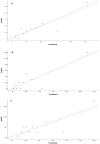Prognostic value of cardiopulmonary exercise test in patients with acute myocardial infarction after percutaneous coronary intervention
- PMID: 39009689
- PMCID: PMC11251163
- DOI: 10.1038/s41598-024-66963-5
Prognostic value of cardiopulmonary exercise test in patients with acute myocardial infarction after percutaneous coronary intervention
Abstract
To determine the independent risk factors of cardiopulmonary exercise test (CPET) parameters related to adverse prognostic events within 5 years in patients undergoing percutaneous coronary intervention (PCI) for acute myocardial infarction (AMI), and establish a prediction model for the occurrence of adverse events within 5 years to provide a reference for cardiac rehabilitation training. From August 2015 to December 2021, patients who underwent PCI for AMI and completed CPET within 1-2 weeks after surgery before discharge from the Department of Cardiovascular Medicine of Zhengzhou Central Hospital Affiliated to Zhengzhou University, Henan Provincial Hospital of Traditional Chinese Medicine, and Anyang District Hospital were selected as participants. Univariate and multivariate analyses were used to screen for independent risk factors associated with 5-year adverse events. Feature importance was interpreted using SHapley Additive exPlanations (SHAP), and a logistic regression model was established for prediction. A receiver operating characteristic (ROC) curve was constructed to evaluate the performance of the prediction model. Calibration was assessed by the Hosmer-Lemeshow test and the calibration curve. In total, 375 patients met the inclusion criteria. Based on whether adverse events occurred during the 5-year follow-up period, the patients were divided into two groups: the event group (n = 53) and the non-event group (n = 322). Peak oxygen uptake (peakVO2), carbon dioxide ventilation equivalent slope (VE/VCO2slop), and peak end-tidal carbon dioxide partial pressure (PETCO2) were three independent risk factors for re-acute myocardial infarction (re-AMI), heart failure (HF), and even death after PCI for AMI (P < 0.05). The SHAP plots demonstrated that the significant contributors to model performance were related to peakVO2, VE/VCO2slop, and PETCO2. The risk of adverse events was significantly reduced when the peakVO2 was ≥ 20 mL/kg/min and the VE/VCO2slop was < 33. The ROC curves of the three models were drawn, including the no-event and event groups, re-AMI group, and HF group, which performed well, with AUC of 0.894, 0.760, and 0.883, respectively. The Hosmer-Lemeshow test showed that the three models were a good fit (P > 0.05). The calibration curve of the three models was close to the ideal diagonal lines. CPET parameters can predict the prognosis of adverse events within 5 years after PCI in patients with AMI and provide a theoretical basis for cardiac rehabilitation training.
Keywords: Acute myocardial infarction; Cardiopulmonary exercise test; Percutaneous coronary intervention; Prediction model; Risk factors.
© 2024. The Author(s).
Conflict of interest statement
The authors declare no competing interests.
Figures






Similar articles
-
Risk analysis and risk prediction of in-hospital heart failure in patients with acute myocardial infarction after emergency intervention surgery.BMC Cardiovasc Disord. 2024 Nov 25;24(1):673. doi: 10.1186/s12872-024-04357-1. BMC Cardiovasc Disord. 2024. PMID: 39587472 Free PMC article.
-
Effect of pre-discharge cardiopulmonary fitness on outcomes in patients with ST-elevation myocardial infarction after percutaneous coronary intervention.BMC Cardiovasc Disord. 2019 Sep 6;19(1):210. doi: 10.1186/s12872-019-1189-x. BMC Cardiovasc Disord. 2019. PMID: 31492095 Free PMC article.
-
Construction and validation of a personalized risk prediction model for in-hospital mortality in patients with acute myocardial infarction undergoing percutaneous coronary intervention.Clinics (Sao Paulo). 2025 Feb 1;80:100580. doi: 10.1016/j.clinsp.2025.100580. eCollection 2025. Clinics (Sao Paulo). 2025. PMID: 39893830 Free PMC article.
-
Development of a prediction model for exercise tolerance decline in the exercise assessment of patients with acute myocardial infarction undergoing percutaneous coronary intervention revascularization in the acute phase.J Thorac Dis. 2023 Aug 31;15(8):4486-4496. doi: 10.21037/jtd-23-554. Epub 2023 Aug 10. J Thorac Dis. 2023. PMID: 37691663 Free PMC article.
-
[Effect of plasma RIPK3 levels on long-term prognosis in patients with acute myocardial infarction undergoing percutaneous coronary intervention].Zhonghua Xin Xue Guan Bing Za Zhi. 2025 Mar 24;53(3):268-273. doi: 10.3760/cma.j.cn112148-20241117-00707. Zhonghua Xin Xue Guan Bing Za Zhi. 2025. PMID: 40091246 Chinese.
Cited by
-
The Effect of Cardiopulmonary Exercise Ability to Clinical Outcomes of Patients with Coronary Artery Disease Undergoing Percutaneous Coronary Intervention.Int J Gen Med. 2024 Dec 14;17:6145-6152. doi: 10.2147/IJGM.S490833. eCollection 2024. Int J Gen Med. 2024. PMID: 39698043 Free PMC article.
References
-
- Lala A, Shah KB, Lanfear DE, Thibodeau JT, Palardy M, Ambardekar AV, McNamara DM, Taddei-Peters WC, Baldwin JT, Jeffries N, Khalatbari S, Spino C, Richards B, Mann DL, Stewart GC, Aaronson KD, Mancini DM, REVIVAL Investigators Predictive value of cardiopulmonary exercise testing parameters in ambulatory advanced heart failure. JACC Heart Fail. 2021;9(3):226–236. doi: 10.1016/j.jchf.2020.11.008. - DOI - PubMed
-
- Niu S, Wang F, Yang S, Jin Z, Han X, Zou S, Guo D, Guo C. Predictive value of cardiopulmonary fitness parameters in the prognosis of patients with acute coronary syndrome after percutaneous coronary intervention. J. Int. Med. Res. 2020;48(8):300060520949081. doi: 10.1177/0300060520949081. - DOI - PMC - PubMed
-
- Nadruz W, Jr, West E, Sengeløv M, Santos M, Groarke JD, Forman DE, Claggett B, Skali H, Shah AM. Prognostic value of cardiopulmonary exercise testing in heart failure with reduced, midrange, and preserved ejection fraction. J. Am. Heart Assoc. 2017;6(11):e006000. doi: 10.1161/JAHA.117.006000. - DOI - PMC - PubMed
MeSH terms
Grants and funding
LinkOut - more resources
Full Text Sources
Medical
Research Materials
Miscellaneous

